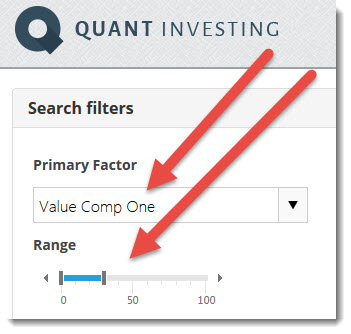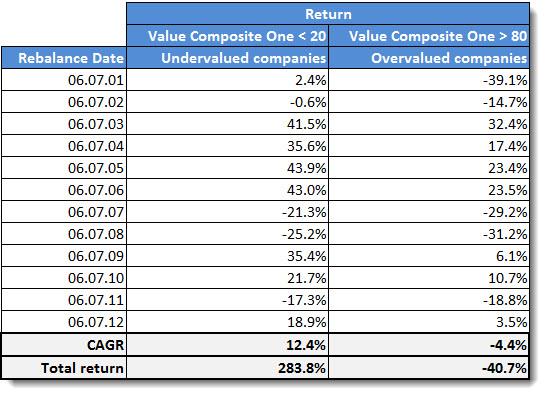I am sure you know that a simple investment strategy like price to book ratio combined with momentum is a very good to use to earn very high returns after a severe market correction. However in times when the markets are neither very undervalued or overvalued, earning yield and momentum may have been a better way to find high return investment ideas.
But if you use only earnings yield it may lead to you missing attractively priced companies in terms of free cash flow, price to earnings or book value.
Your answer - a combination of ratios
To make sure you look at all these valuation ratios it is best to use a combination of valuation ratios - pulled together into one indicator.
Already done for you
Luckily for us someone has already developed such a combination of valuation ratios and tested it to make sure it can give you market beating returns.
James O’Shaughnessy in his excellent book What works on Wall Street found that companies selected based on a number of valuation measurements outperformed companies undervalued on any single valuation ratio 82% of the time in all 10-year rolling periods between 1964 and 2009.
Called Value Composite One
James called his collection of valuation ratios Value Composite One (VC1) and it is calculated using the following five valuation ratios:
- Price to book value
- Price to sales
- Earnings before interest, taxes, depreciation and amortization (EBITDA) to Enterprise value (EV)
- Price to cash flow
- Price to earnings
How is the value Composite One ranking calculated?
To calculate the Value Composite One ranking you give a percentile ranking (1 to 100) to each of the five valuation ratios for each company.
For example if a company has a price to sales ratio that is in the lowest one percent for our database, it gets a rank of 1 (lower is more undervalued) and if a company has a PE ratio in the highest one percent (it is overvalued) of all the companies in your database you will give it a rank of 100.
If a value is missing, for example because a company made losses and no price earnings ratio is available, in the screener we assign a neutral value of 50 for the ratio.
Once all the valuation ratios have been ranked you add up all the values (of the 5 valuation ratios) for each company and (using this value) rank all the companies in percentiles (from 1 to 100).
Undervalued = 1 and overvalued = 100
Companies that are the most undervalued get Value Composite One rank of 1 those with the worst score (most expensive or overvalued company) get a rank of 100.
Click here to start using Value Composite One in your portfolio Now!
Our 12 year back test...
As with most of the strategies in the screener (remember we use the screener for our own investments) we have back tested the returns you could have made if you used the Value Composite One indicator as an investment strategy for the 12 years from June 2001 to June 2012.
Total return of 283%, market only 73%
If over this period you bought non-financial companies (in Europe EU, the UK, Switzerland and Scandinavia) with the Value Composite One value of less than 20 (undervalued companies) you would have earned a respectable 12.4% per year or 283% in total.
This compares very well to the 4.9% per year or 73% of all the companies (effectively the market) we tested.
We also tested what would have happened if you only bought companies with a Value Composite One value of more than 80, in other words the 20% most overvalued companies. Over the same 12 year period from June 2001 to June 2012 you would have lost 4.4% per year for a total loss of 40.7% over 12 years.
Results summarised
CAGR = Compound annual growth rate
(Index return = 4.9% per year and 73% over the 12 year period)
If you want an even higher return
That we did not test (a future project) is what returns you could have earned if you combined the Value Composite One score with another factor like the top 20% of companies in terms of 6 month Price Index, F-score or shareholder yield for example.
It is very likely that your returns will be substantially higher as you saw with the two factor strategies we tested in the research paper Quantitative Value Investing in Europe: What works for achieving alpha.
Click here to start using Value Composite One in your portfolio Now!
Where to find it in the screener
You can easily find undervalued companies using the Value Composite One indicator in the Quant Investing stock screener.
This can be done as a primary screening factor as shown below:

Slider makes it easy
The slider allows you to easily select the range of Value Composite One value companies, cheapest 30% in the above screenshot.
Sort by Value Composite One
You can also sort any screen you run by Value Composite One. To do this select it as an output column and click on the column heading once to sort it from low to high.
PS Everything you need to implement this investment strategy in your portfolio can be found here.
PPS Why not sign up now while it is still fresh in your mind. You can cancel at any time for a FULL refund if you are not happy. Sign up here.
Additional reading:
How and why to implement a Value Composite One investment strategy world-wide
Click here to start using Value Composite One in your portfolio Now!



